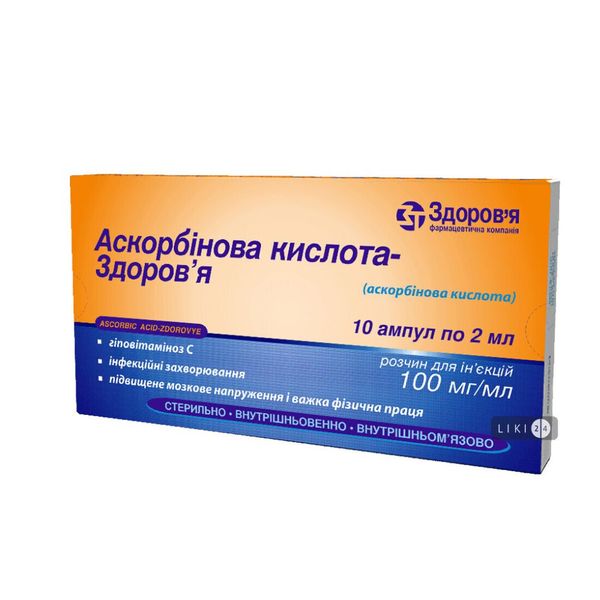|
Quantity
|
Out of stock
|
||
|
|
|||
Composition
active ingredient: ascorbic acid;
1 ml of solution contains ascorbic acid 50 mg;
excipients: sodium hydrogen carbonate, sodium sulfite anhydrous (E 221), water for injection.
Dosage form
Injection solution.
Pharmacotherapeutic group
Simple ascorbic acid preparations. Ascorbic acid (vitamin C).
ATC code A11G A01.
Pharmacological properties
Pharmacodynamics.
Ascorbic acid (vitamin C) is a water-soluble vitamin that promotes optimal tissue metabolism. It takes an active part in oxidation-reduction reactions, forming a hydrogen proton transfer system with dehydroascorbic acid, exhibits antioxidant properties, thereby ensuring the stability of cell membranes. It takes part in the synthesis of the main substance of the connective tissue of the vascular wall, thus preventing the development of hemorrhagic diathesis. It is not synthesized in the human body. With insufficient intake of ascorbic acid with food, bleeding gums and mucous membranes develop. It takes part in glucose metabolism, cholesterol catabolism, and the synthesis of steroid hormones. During stress reactions, the content of ascorbic acid in the body, and in the tissue of the adrenal glands in particular, is significantly reduced, which confirms the participation of ascorbic acid in adaptation reactions. It is capable of exerting an antianemic effect due to the effect on iron metabolism. It restores trivalent iron to divalent iron, which is transported with the bloodstream.
Pharmacokinetics.
Ascorbic acid after parenteral administration easily penetrates leukocytes, platelets, and then all tissues; it accumulates mainly in organs with an increased level of metabolic processes, in particular in the tissues of the adrenal glands. It is found in tissues both in a free state and in the form of compounds. It is excreted from the body with urine both unchanged and as metabolites.
Alcohol consumption and smoking accelerate the destruction of ascorbic acid (conversion into inactive metabolites), sharply reducing its reserves in the body.
Indications
Hypovitaminosis C; scurvy, bleeding (uterine, pulmonary, nasal, hepatic), hemorrhagic diathesis, bleeding as radiation sickness syndrome, various intoxications and infectious diseases, nephropathy of pregnancy, Addisonian crisis, overdose of anticoagulants, bone fractures and sluggish granulating wounds, various dystrophies, pregnancy and breastfeeding, increased mental stress and heavy physical labor.
Contraindications
Increased individual sensitivity to ascorbic acid or to any of the auxiliary components of the drug. Diabetes mellitus, increased blood clotting, tendency to thrombosis, thrombophlebitis, urolithiasis (including hyperoxaluria), renal failure, progressive malignant diseases, hemochromatosis, thalassemia, polycythemia, leukemia, sideroblastic anemia, sickle cell anemia, glucose-6-phosphate dehydrogenase deficiency.
Interaction with other drugs and other types of interactions
Ascorbic acid increases the concentration of salicylates in the blood (increases the risk of crystalluria), ethinyl estradiol, benzylpenicillin and tetracyclines, reduces the level of oral contraceptives in the blood. Increases the excretion of drugs that have an alkaline reaction (including alkaloids). In high doses, it increases the renal excretion of mexiletine.
Tetracyclines and acetylsalicylic acid increase the excretion of ascorbic acid in the urine.
When administered simultaneously with salicylates and short-acting sulfonamides, the risk of urinary calculi increases.
High doses of ascorbic acid can reduce urine pH, thereby reducing tubular reabsorption of amphetamine and tricyclic antidepressants that are used simultaneously.
Increases iron excretion in patients taking deferoxamine.
Reduces the anticoagulant effect of coumarin and heparin derivatives, the effectiveness of antibiotics.
Increases the detoxification and total clearance of ethyl alcohol.
Reduces the chronotropic effect of isoprenaline and the therapeutic effect of phenothiazine derivatives.
When used simultaneously with barbiturates, primidone, the excretion of ascorbic acid in the urine increases.
When using ascorbic acid in large doses and simultaneously drinking alcohol, disulfiram-like reactions may develop.
Method of administration and dosage
Prescribed intravenously by jet or drip and intramuscularly.
Intravenously by jet over 1-3 minutes. For intravenous drip administration, a single dose of the drug is dissolved in 50-100 ml of 0.9% sodium chloride solution and administered by slow intravenous infusion at a rate of 30-40 drops per minute.
Intramuscularly, it is administered deep into the muscle.
Doses are determined individually, taking into account the nature and severity of the disease.
Adults and children over 12 years of age are usually prescribed 50-150 mg per day. In case of poisoning, the daily
the dose is increased to 500 mg. The maximum single dose is 200 mg, daily dose is 1 g.
Children under 12 years of age are prescribed intravenously in a daily dose of 5-7 mg/kg of body weight in the form of a 5% solution (0.5-2 ml). Usually, the daily doses for children are: under 6 months - 30 mg, 6-12 months - 35 mg, 1-3 years - 40 mg, 4-10 years - 45 mg, 11-12 years - 50 mg.
The maximum daily dose is 100 mg.
Special groups of patients. For patients with recurrent kidney stones, the daily dose of ascorbic acid should not exceed 100-200 mg. For patients with severe or terminal renal failure (patients on dialysis), the daily dose of ascorbic acid should not exceed 50-100 mg. For patients with glucose-6-phosphate dehydrogenase deficiency, the daily dose of ascorbic acid should not exceed 100-500 mg.
Children
The drug is used in pediatric practice.
See the section "Dosage and Administration" for doses of the drug for children.
When used in high doses, it is necessary to monitor renal function, blood pressure (stimulation of corticosteroid formation by ascorbic acid), and pancreatic function (inhibition of the insular apparatus).
High-dose therapy should not be administered to patients with a tendency to recurrent urolithiasis. Patients with renal failure should be provided with sufficient fluid intake (1.5-2 liters per day) to reduce the risk of crystalluria.
The use of large doses of ascorbic acid may affect the results of some laboratory tests: a false-positive test for the presence of sugar in the urine and a negative test for the presence of occult blood in the feces, as well as a decrease in the results of studies of the concentration of lactate dehydrogenase and aminotransferases in the blood serum.
Patients with increased iron content in the body should use ascorbic acid in minimal doses.
Patients who are on a low-sodium diet should not be prescribed high doses of the drug.
Prescribing ascorbic acid to patients with tumors that rapidly proliferate and intensively metastasize can intensify the course of these processes. Patients undergoing chemotherapy should be prescribed the drug no earlier than 1-3 days (depending on the half-life of the antitumor drug) after chemotherapy, since there is no clinical data on possible interactions.
Side effects
From the blood and lymphatic system: with prolonged use in high doses - thrombocytosis, hyperprothrombinemia, thrombus formation, erythrocytopenia, neutrophilic leukocytosis.
From the nervous system: headache, feeling of fatigue, with prolonged use in high doses - sleep disturbance, increased excitability of the central nervous system.
From the digestive system: nausea, diarrhea, stomach cramps.
From the urinary system: hyperoxaluria; with prolonged use in high doses - damage to the glomerular apparatus of the kidneys, formation of kidney stones from calcium oxalate.
From the skin and subcutaneous tissue: very rare - skin rash, hyperemia of the skin, itching, urticaria.
Metabolic disorders: hypervitaminosis C, with prolonged use in high doses - inhibition of the insular apparatus of the pancreas (hyperglycemia, glucosuria) and glycogen synthesis, sodium and fluid retention, zinc and copper metabolism disorders.
From the cardiovascular system: decreased capillary permeability, deterioration of tissue trophism; with prolonged use in high doses - myocardial dystrophy, increased blood pressure, development of microangiopathies.
General disorders: with intravenous administration, a feeling of heat, changes at the injection site are possible.
Pregnancy: with intravenous administration in high doses - threat of termination of pregnancy.
From the immune system: very rare - hypersensitivity reactions, including anaphylactic shock.
Shelf life
2 years.
Storage conditions
Store in the original packaging at a temperature not exceeding 25 ° C.
Keep out of the reach of children.































